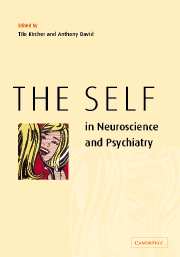Book contents
- Frontmatter
- Contents
- List of contributors
- Introduction: the self and neuroscience
- Part I Conceptual background
- Part II Cognitive and neurosciences
- 5 The multiplicity of consciousness and the emergence of the self
- 6 Asynchrony, implicational meaning and the experience of self in schizophrenia
- 7 Self-awareness, social intelligence and schizophrenia
- 8 The neural correlates of self-awareness and self-recognition
- 9 Autonoetic consciousness
- 10 The neural nature of the core SELF: implications for understanding schizophrenia
- Part III Disturbances of the self: the case of schizophrenia
- References
10 - The neural nature of the core SELF: implications for understanding schizophrenia
from Part II - Cognitive and neurosciences
Published online by Cambridge University Press: 18 December 2009
- Frontmatter
- Contents
- List of contributors
- Introduction: the self and neuroscience
- Part I Conceptual background
- Part II Cognitive and neurosciences
- 5 The multiplicity of consciousness and the emergence of the self
- 6 Asynchrony, implicational meaning and the experience of self in schizophrenia
- 7 Self-awareness, social intelligence and schizophrenia
- 8 The neural correlates of self-awareness and self-recognition
- 9 Autonoetic consciousness
- 10 The neural nature of the core SELF: implications for understanding schizophrenia
- Part III Disturbances of the self: the case of schizophrenia
- References
Summary
Abstract
Schizophrenia is largely an organic disease that impacts many brain systems, especially those mediating cognition–emotion interactions. The present analysis is premised on the existence of a variety of basic emotional operating systems of the brain – birthrights that allow all newborn mammals to begin navigating the complexities of the world and to learn about the values and reward-related contingencies of the environment. Some of the basic emotional systems have now been provisionally characterized, and they help coordinate behavioural, physiological and psychological aspects of emotionality, including the valenced affective feeling states that provide internally experienced values for the guidance of behaviour. Converging lines of evidence suggest that emotional feelings emerge from the interaction of these systems with longitudinally organized brain process for self-representation that is concentrated in the medial strata of the brain. These include anterior cingulate, insular and frontal cortices, which are richly connected to various medial diencephalic and mesencephalic structures, especially the periaqueductal grey (PAG). This basic neural substrate for self-representation appears to be grounded in stable motor coordinates that generate emotion-specific intentions in action, yielding a variety of feeling states that help construct mood-congruent cognitive structures. These systems generate a sense of causality from correlated environmental events and hence promote the emergence of both adaptive and delusional cognitive states. Certain symptoms of schizophrenia may reflect the uncoupling of the higher cognitive and the lower affective processes, disrupting normal modes of emotion regulation and reality testing.
- Type
- Chapter
- Information
- The Self in Neuroscience and Psychiatry , pp. 197 - 214Publisher: Cambridge University PressPrint publication year: 2003
References
- 4
- Cited by

